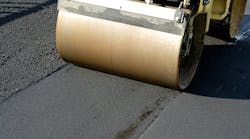About the author: Philip Kresge is senior director of national resources for the National Ready Mixed Concrete Assn. Kresge can be reached at [email protected] or 610.966.7220.
Most industry professionals today are aware that pervious concrete can be a vital component of an infiltration-style storm water management system. What is becoming clearer now is that pervious concrete also may provide relief from urban heat islands (UHIs).
Pervious concrete is a unique and innovative means of managing storm water. A pervious concrete mixture contains little or no sand, creating a substantial void content. Typically, 15% to 25% voids are achieved in the hardened concrete; flow rates for water through pervious concrete are about 3 to 5 gal per minute per square foot (275 to 450 in. of rain per hour), depending on that void content.
When combined with a detention layer of stone, pervious concrete pavement is an intricate part of a designed infiltration-style storm water management system. In fact, a pervious concrete infiltration system is among the most effective best management practices recommended by the U.S. Environmental Protection Agency for controlling storm water runoff on a regional and local basis.
From an environmental perspective, among pervious concrete’s primary benefits is a reduction in the total volume of runoff that otherwise carries substantial amounts of pollutants into streams, rivers, lakes and oceans. Through infiltration, not only is the volume of storm water greatly reduced, but pervious concrete also effectively provides first-flush pollution mitigation. Approximately 90% of the pollutants are carried away in the first 1.5 in. of a typical significant rain event.
The filtration provided by the voided matrix within pervious concrete retains at least 80% of the organic pollutants, and naturally occurring microbial growth provides further treatment before the few pollutants that remain are converted by native soils. Additionally, the infiltration provided by pervious concrete recharges groundwater and provides irrigation to nearby surface vegetation and tree root systems.
One aspect of pervious concrete that often is overlooked is its contribution to reducing air and water temperatures. Recent studies suggest that the physical properties of pervious concrete can offer desirable heat-island mitigation. In its Leadership in Energy and Environmental Design (LEED) Green Building Rating System, the U.S. Green Building Council (USGBC) uses a solar reflective index (SRI) to evaluate a material’s UHI mitigation capabilities. USGBC has targeted an SRI of 29 or higher to qualify for related LEED credits.
With an SRI in the range of 38 to 52, conventional concrete easily qualifies as a default material. Pervious concrete has a lower average SRI than conventional concrete due to its open-graded surface and may not satisfy
the targeted SRI of 29. One could argue, however, that this open-pore structure should offer thermal insulation benefits via heat transfer to the ground below and thus provide some degree of UHI mitigation.
Put to the Test
This is the theory that Dr. John Kevern, University of Missouri at Kansas City; Dr. Liv Haselbach, Washington State University; and Dr. Vernon Schaefer, Iowa State University (ISU) considered in their study “Hot Weather Comparative Heat Balances in Pervious Concrete and Impervious Concrete Pavement Systems.” Noting that granular ground surfaces composed of soils or sands did not contribute to UHI, Kevern, Haselbach and Schaefer set out to demonstrate that pervious concrete would perform in a similar manner. Previous studies had shown that the temperature at the surface of pervious concrete may be elevated compared to traditional impervious pavements, but it decreased rapidly beneath the pavement.
The study focused on a parking lot at ISU using both pervious concrete and conventional concrete pavements with temperature sensors in the concrete and at selected levels beneath. On the pervious side, sensors were placed at mid-level in the concrete (8 cm), mid-level in the aggregate base (40 cm) and at the bottom of the aggregate base (60 cm). The conventional concrete had a sensor mid-level in the concrete (8 cm), at the concrete/soil interface (15 cm) and at two levels in the soil (15 and 45 cm). Temperature readings were taken for both pavements on five separate days during which air temperatures exceeded 90°F and there had been no rain events in the preceding seven days.
Energy stored in each of the pavement systems was calculated based on the various temperature readings at the corresponding sensors. For the five days analyzed, the energy stored in the conventional concrete system was greater than the energy stored in the pervious concrete system, even though the pervious concrete pavement itself was warmer. This difference in heat stored is a function of the higher porosity in both the pervious concrete and the aggregate base as compared to the density of the conventional concrete and underlying soil, respectively.
The void structure of the pervious concrete and aggregate base acted in an insulating capacity, lowering the pervious concrete system heat capacity. The pervious concrete system averaged 12% less energy stored than the traditional concrete from the surface to a background temperature.
Additionally, the rainwater infiltration allowed by pervious concrete can keep the recesses of pavement cool through moisture evaporation. This helps further mitigate thermal pollution by reducing the temperature of the water at the point of infiltration. Results from a recent study at Villanova University showed as much as a 5°F difference in water temperature between a pervious concrete infiltration system and adjacent pavements.
In the latest draft of the upcoming International Green Construction Code, pervious concrete will be considered a default material for heat island mitigation due to its open-pore structure and corresponding benefits. The concrete industry is encouraging USGBC to do likewise as it reviews and revises its LEED program.
Download: Here

